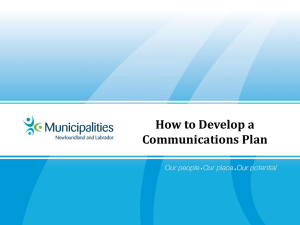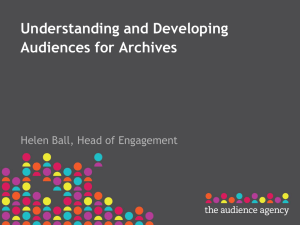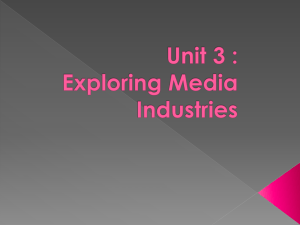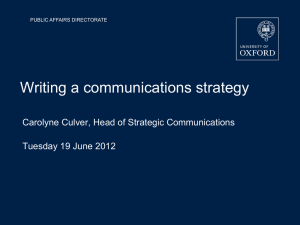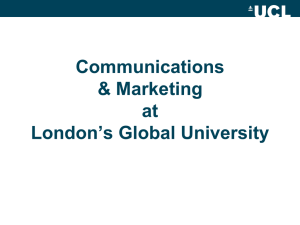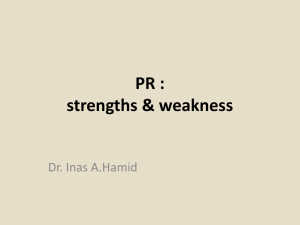Corporate Communication: An Introduction
advertisement
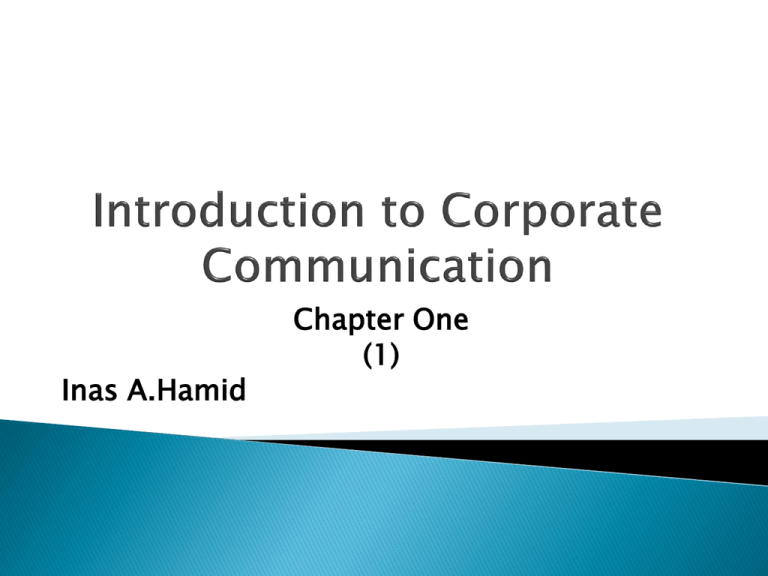
Inas A.Hamid Chapter One (1) Customer s Top management The Public Production Unit HR Employees Finance Media PR Government Customer Service Investors Corporate Communication Why do corporations need to develop effective communication? Organizations need communication to : Acquire resources they need in order to operate. Communicate with different stakeholders. Communication with employees to increase their loyalty. Influence the environment within which they operate. Retain their license to operate. Improve the image. Encourage all employees to work together to support the company's objectives. Develop the corporate branding. Corporate Communications Vertical & Horizontal Help the organization to : - Create Images - Build a strong brand - Develop Reputation Internal & External Formal & Informal Management Comm. Organizational Comm. Marketing Comm. Management level of the organization (all employees with authority) Persuade audiences that the goals of the organization are worth achieving Internal audiences External audiences Communication is one of the most important skills a manager must have to : ◦ gain the acceptance for the organization's goals. ◦ Develop a shared vision of the company within the organization. ◦ Establish and maintain trust in the organization's leadership. ◦ Initiate and manage the change process. Communication specialist are needed to support managers in improving the effectiveness of their communications. Communications between the organization and its audiences (investors, the public, share holders, financial journalist, investment analyst, regulators, legislators….). Do not directly aim at generating sales but at developing long – term relationship. Apply a different style of communication: messages are more formal and honest. Initiated by external parties and that means the audiences decide whether the organization should communicate with them. MarCom is very important to support management communications. MarCom gets the bulk of the budget in most organizations. Traditionally termed promotion. It is a part of the 4Ps marketing mix (product, price and place). It aims at facilitating the process of exchange. The organizations choose the target market and avoid communicating with those that are not commercially interesting. Marketing communication: all forms of communication between an organization and its customers and potential customers, that facilitate exchanges by establishing shared meaning with the brand’s customers or clients. Public Relations Packaging Advertising Word Of mouth Sponsorship Consumer audiences Channel Audiences All Stakeholders Audiences Exhibitions Internal Marketing Websites Sales Promotion Branding Personal Selling Branding The most important practices to achieve Corporate integrated communications are: ◦ ◦ ◦ ◦ Use of integrated marketing communications (IMC). Application of visual identity systems (house style). Depending on team works. Adoption of a centralized planning system. In recent years organizations become aware of the need to produce consistent messages (free of contradictions) and this what we can call “ Integrated marketing communication” to describe a process for building a fully coordinated communication system inside the organization. identifying all target audiences. Segmenting audiences on the basis of stage in the purchase decision cycle. Determining messages and communications tools to reach each segment. Allocating resources To produce consistent themes on products and services through the use of common names, logos, sounds, packaging, furniture, building design and even smells. This led to the emergence of “identity firms” that help the organization to develop a uniform set of symbols, guidelines for employees to create a uniform image for the organization(clothing, way of greetings….). Integrated communication •Common policy and evaluate its execution. Team Work •Mobilized employees Coordinated teams It is a software that can be used to ◦ set up and manage communication projects targeted to internal and external audiences. ◦ Manage and control at a general level by providing employees with certain information. ◦ Offers standard structure of reports that can be used in various situations. Gruing & Hunt (1984)developed four types of PR practices focusing on the nature of communication in different organizations. These types are : ◦ Press agent- propaganda ◦ Public information ◦ Two – way asymmetric communication. ◦ Two – way symmetric communication. According to Gruing point of view: The first model “propaganda” is the least desirable form of communication because: ◦ it involves a one-way flow of information. ◦ The organization is not honest about its activities and it effects on the community. ◦ They will also resist efforts to establish a dialogue about it. The fourth is the best type. ◦ It involves a company in two-way symmetric communication. ◦ Under this model, both parties are open and truthful about each other's point of view to arrive at a common understanding. Types Press agent propaganda Public information Two-way asymmetric Two-way symmetric Purpose Propaganda Transmit facts Feedback & persuasion Mutual understandi ng Communication One-way ,little respect to truth - One-way - truthful, complete facts Two-way , in favor of the sender, accurate info. Tow-way ,balance interest. Type of organization Entertainment & sport Organizations -Non- Profit& governmental organizations -Instructions about health and safety procedures given to employees. PR agencies, competing Organizations , pharmaceutic al organizations. • Apply KAB model Identity Brand Communication policies • Apply PPT model Common starting points Strategy Effective Corporate communication Depends on ensuring that the organization's communications policies are derived from the core strategy-identity-brand (SIB) to develop a set of “common starting points” The corporate strategy can be translated into common starting points by applying the PPT model as : indicate what the organization wants to Promise to its most important internal and external stakeholders; indicate how it expects to Prove it ; and identify what Tone of voice it wants to use to communicate messages to those audiences. Make plans more specific by applying the KAB model as: specify what the organization wants target groups to know (knowledge), to feel (attitude)and to do (Behavior), both with respect to the entire company and with respect to the individual business unit. What will happen if the organizations' departments are not coordinated in the way of creating consistency messages? How can organizations limit fragmentation in their communications?
